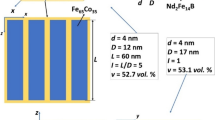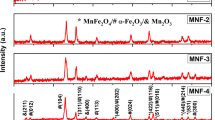Abstract
Fe nanowire array with strong shape anisotropy was employed as the soft phase in Nd-Fe-B based nanocomposites. The effects of the Fe nanowire distribution on magnetic properties of the nanocomposites were investigated by micromagnetic simulation. The results indicate that the shape anisotropy of Fe wires added in the same direction as the uniaxial magnetocrystalline anisotropy of the hard phase cannot increase the coercivity of the nanocomposite. When the nanowires are distributed perpendicular to the easy axis of the hard phase, the shape anisotropy of soft phase can retard the moments from rotating to the full reversed direction, leading to enhanced coercivity. In addition, with increasing the nanowire diameter, the coercivity of the nanocomposite decreases, but the dipolar interaction shows different roles in magnetic reversal of nanocomposite for different distributions of nanowires. The current results suggest that the coercivity of the Nd2Fe14B/α-Fe nanocomposite can be enhanced by introducing the soft magnetic nanowire array with the diameter less than the exchange length and with the long axis along the direction other than the easy axis of hard phase.
Similar content being viewed by others
References
Coehoorn R, de Mooij D B, de Waard C. Meltspun permanent magnet materials containing Fe3B as the main phase. Journal of Magnetism and Magnetic Materials, 1989, 80(1): 101–104
Liu Z W, Zhao L Z. Compositional optimization and new processes for nanocrystalline NdFeB-based permanent magnets. In: Advances in Magnetic Materials: Processing, Properties, and Performance. CRC Press, 2017, 293–372
Zhang X Y, Wen G H, Chan Y F, et al. Fabrication and magnetic properties of ultrathin Fe nanowire arrays. Applied Physics Letters, 2003, 83(16): 3341–3343
Yang S, Zhu H, Yu D, et al. Preparation and magnetic property of Fe nanowire array. Journal of Magnetism and Magnetic Materials, 2000, 222(1–2): 97–100
Li W, Zhou Q, Zhao L Z, et al. Micromagnetic simulation of anisotropic grain boundary diffusion for sintered Nd–Fe–B magnets. Journal of Magnetism and Magnetic Materials, 2018, 451: 704–709
Li W, Zhao L Z, Zhou Q, et al. Effects of grain boundary configuration and characteristics on the demagnetization process and coercivity of anisotropic NdFeB magnets. Computational Materials Science, 2018, 148: 38–45
Fukunaga H, Ikeda M, Inuzuka A. A new type of nanocomposite magnets including elongated soft magnetic grains — computer simulation. Journal of Magnetism and Magnetic Materials, 2007, 310(2): 2581–2583
Aharoni A. Introduction to the Theory of Ferromagnetism. Clarendon Press, 2000
The Object Oriented MicroMagnetic Framework (OOMMF). Available on line: http://math.nist.gov/oommf/(accessed April, 15, 2018)
Kneller E F, Hawig R. The exchange-spring magnet: a new material principle for permanent magnets. IEEE Transactions on Magnetics, 1991, 27(4): 3588
Skomski R, Hadjipanayis G C, Sellmyer D J. Effective demagnetizing factors of complicated particle mixtures. IEEE Transactions on Magnetics, 2007, 43(6): 2956–2958
Hubert A, Schäfer R. Magnetic Domains: The Analysis of Magnetic Microstructures. Springer Science & Business Media, 2008
Schrefl T, Fidler J. Micromagnetic simulation of magnetizability of nanocomposite Nd–Fe–B magnets. Journal of Applied Physics, 1998, 83(11): 6262–6264
Porter D G, Donahue M J. Generalization of a two-dimensional micromagnetic model to non-uniform thickness. Journal of Applied Physics, 2001, 89(11): 7257–7259
Baik J M, Schierhorn M, Moskovits M. Fe nanowires in nanoporous alumina: Geometric effect versus influence of pore walls. The Journal of Physical Chemistry C, 2008, 112(7): 2252–2255
Lu B, Huang M Q, Chen Q, et al. Magnetic coupling in boron-rich NeFeB nanocomposites. Journal of Applied Physics, 1999, 85(8): 5920–5922
Acknowledgements
This work was supported by the National Natural Science Foundation of China (Grant No. 51774146), the Guangdong Provincial Science and Technology Program (Grant no. 2015B010105008), the Guangzhou Municipal Science and Technology Program (Grant No. 201707010161), and the Fundamental Research Funds for Central Universities (Grant No. 2015ZP030).
Author information
Authors and Affiliations
Corresponding author
Rights and permissions
About this article
Cite this article
Li, W., Zhao, L. & Liu, Z. Micromagnetic simulation on magnetic properties of Nd2Fe14B/α-Fe nanocomposites with Fe nanowires as the soft phase. Front. Mater. Sci. 12, 348–353 (2018). https://doi.org/10.1007/s11706-018-0436-x
Received:
Accepted:
Published:
Issue Date:
DOI: https://doi.org/10.1007/s11706-018-0436-x




